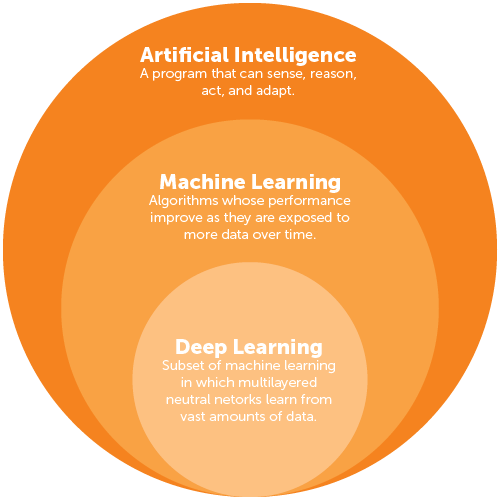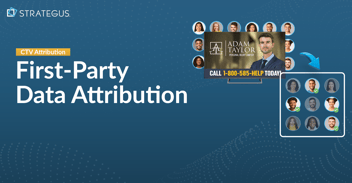- Home
- Strategus Blog
- The Role of AI in Programmatic Advertising (2025 Guide)
The Role of AI in Programmatic Advertising (2025 Guide)
 Traci Ruether
Traci Ruether
11 minutes read

Few business functions will be impacted so profoundly by artificial intelligence (AI) as marketing. The recent explosion in AI has paved the way for countless new applications across the sector. And in fact, AI-powered marketing was already more common than most of us realize.
The reason for this is simple: Technology and marketing go hand in hand. The two have been entwined since the first banner ad popped up in 1994 — giving way to specialties like ad tech, mar tech, and digital marketing.
Today, all marketing efforts are rooted in digital. That’s why print media uses QR codes and radio ads direct listeners to a company’s website. Even mom-and-pop laundromats must show up on Google to attract new customers.
This reliance on tech is why AI already plays such a prominent role in marketing activities. Search engine algorithms, programmatic ad buying, and digital analytics have all been AI-powered for 10+ years.
So what’s changed?
Large-scale language models like ChatGPT have pushed us into a new era. Whereas traditional AI could handle specific tasks like media placement, today’s AI can adapt to different tasks through ongoing data ingestion and prompt-based learning.
When it comes to the tangible ways that AI will push marketing into a new frontier, there’s a lot to get excited about. Generative AI capabilities will transform marketing functions across the board, and the very concept of marketing will reorient itself around this new reality.
Say you’re a media buyer hoping to test multiple versions of an ad. With AI, you’ll soon be able to spin up variations, test performance, and optimize your campaigns mid-flight based on the findings.
Or perhaps you’re a CMO looking to create TV-ready ads without hiring a video producer. Text-to-video tools like Synthesia make it easy to create professional videos in minutes without acting talent, equipment, or video expertise.
Keep reading for a closer look at how AI is being used in programmatic advertising and digital marketing today — as well as where we’re headed.
The Role AI Has traditionally played
AI has always been the driving force behind programmatic advertising. This real-time automation of media buying delivers personalized ads based on user data. Programmatic ad platforms like the Trade Desk, Google’s Display & Video 360, and Yahoo DSP use algorithms to allocate ad spending and adapt targeting without human intervention in mere milliseconds. As a result, AI already powers everything from the commercials that play when you watch CTV to the sponsored ads that show up on Google.
But that’s not all.
As a digital marketer myself, I’ve used AI tools and attempted to game AI algorithms for years. In fact, I just pasted the previous section into the AI-powered Hemmingway Editor to check its readability.
Other common examples of AI in digital marketing include:
- Writing assistants like Grammarly
- SEO algorithms like Google Search
- Content recommendations on platforms like YouTube
- Social algorithms like your LinkedIn feed
- Chatbots like Siri
- Marketing analytics tools like Google Analytics
The point is, AI-powered marketing isn’t new. But the promise of new generative AI models goes way beyond these examples.
That’s because we’ve moved from generic AI to its more sophisticated subset: deep learning. Modeled after the human brain, deep learning relies on networks made up of thousands of interconnected nodes (neurons). This allows for computationally intensive functions such as image recognition, sound recognition, and natural language processing.

These neural network architectures are what platforms like ChatGPT, Bard, and DALL-E use to make sense of vast amounts of data and generate on-demand content. What’s more, with the frenzy of AI that’s taken place over the past year, these generative AI models are now at everyone’s fingertips.
Because AI is an umbrella for deep learning and machine learning (ML), I’ll stick with that term throughout this article.
The role AI will soon play in programmatic advertising
Imagine there’s a single, wealthy golfer named Tim in the market for a car. Meanwhile, his neighbor Linda down the street (who’s also been shopping for her next car, but wants a family-friendly option) is a tennis player. By gathering data from disparate sources, analyzing it, and spinning up new versions of a generic commercial, AI could create bespoke CTV campaigns for each viewer.
The result? Tim sees a commercial with a Lexus convertible pulling up to his favorite golf course — with gold clubs fitting perfectly in the trunk. Meanwhile, Linda sees a commercial for a Lexus SUV heading to the tennis court. Both ads spark interest due to the personalization of the message, but Linda changes the channel because she’s already decided on a Volkswagen Atlas.
Later that night when Tim checks the weather online, he is retargeted with a display ad for the same Lexus convertible. He gets excited about pulling up to his weekend golf game in a new car and clicks the ad.
This engagement is tracked from end to end, collecting data from that first impression to the moment he walks into a dealer to buy the car. Tim’s also tracked beyond that — such as when he registers the new car at the DMV and begins buying accessories like floor mats. And so, the programmatic AI tool working behind the scenes iterates on this proven formula. Similar buyers are targeted with look-alike campaigns that are further tweaked to their interests and optimized for the ideal media mix, frequency, call to action, and more.
This type of sophisticated targeting and real-time testing is on the frontier. We’re not quite there yet. But the tech supporting it has arrived. Let’s start by looking at the AI content creation that’s already changing the game.
AI Content Creation
Many of the nay-sayers' concerns about AI’s capabilities are valid. Jobs will be made obsolete, creative pursuits will be delegated to robots, and large-scale automation will generate big bucks for corporate giants. But there will be nuances, too.
As some jobs go the way of the dinosaurs, entirely new job titles will crop up. Likewise, human artists will work alongside machine artists to push creativity to new heights.
Just take a look at Coca-Cola’s Masterpiece commercial below, which was made partly using AI.
The ad fuses live-action shots, digital effects, and stable diffusion AI to take viewers on a stunning journey through art history. A Coke bottle traveling through an art gallery is reimagined to match the universe of each work of art that it visits — including Van Gogh’s “Bedroom in Arles” and Vermeer’s “Girl with a Pearl Earring.”
Exactly how extensive of a role AI played in the making of this commercial remains vague. Coca-Cola isn’t super forthcoming, and in fact, their AI-powered marketing efforts are part of a larger brand play.
Rather than celebrating AI, the commercial celebrates human-made art. And for now, this is a better way to think about AI content creation: As a team sport involving humans and machines.
Democratizing content creation and enabling rapid iteration
As an extension of their investment in AI, Coca-Cola is also partnering with ChatGPT and DALL-E for their “Create Real Magic” campaign. The interactive project invites digital artists to create ads using Coca-Cola’s new AI platform. Users can generate digital ads by providing text inputs. The algorithms take it from there, producing the graphics and copy on demand.
So what's in it for contributors? Winning entries will appear on digital billboards across the world. It’s a win-win: Coca-Cola gets free ads and contributing artists get a global platform. Plus, the interactive experience is fun to play around with.
For both the Masterpiece commercial and the Create Real Magic campaign, AI doesn’t replace the human artist. Rather, it enhances the speed and quality of what human creators can pull off.
Coca-Cola’s Chief Marketing Officer Manolo Arroyo explains:
“We’re just scratching the surface of what we believe will help create the industry’s most effective and efficient end-to-end marketing model. We will begin to leverage OpenAI’s technology in our marketing function to reimagine how we produce creative content, increasing the velocity from weeks to days. We see many applications of AI – including content creation and rapid iteration, hyper-personalizing content and messaging for consumers and customers, and driving two-way conversations with consumers.”
The rapid iteration and hyper-personalization of marketing efforts will have a profound impact, and it’s in these areas that AI-powered content creation will streamline activities that once required human staff.
Simple tasks like localizing content, repurposing it for other channels, and tweaking based on target buyers will thus be automated. As a result, some entry-level jobs will be handed off to robots. But skilled artists, subject matter experts, thought leaders, and influencers will become all the more necessary to deliver on our need for authenticity.
DYNAMIC CREATIVE FOR REAL-TIME TESTING
Among the more exciting applications of AI in digital marketing is the ability to create, test, and optimize advertising efforts on the fly. Consider the graphic below.
- Optimizing creative: With AI, we could generate hundreds of variations with different button colors, call-to-action text, imagery, and headlines. This would allow us to determine the very best combination of creative elements based on performance.
- Optimizing distribution: Beyond testing the creative components, we could test the distribution variables like device type, ad placement, frequency, and more.
- Putting it all together: Say a purple button that says ‘Learn More’ works best when targeting media buyers viewing the ad within a blog; whereas a blue button that says ‘Contact Us Now’ performs best when targeting CMOs browsing on LinkedIn. No problem. AI will make it easy to adapt these variables to the specific context and deliver personalized campaigns at scale.
DATA AUTOMATION AND INTEGRATION ACROSS THE DIGITAL LANDSCAPE
Data is the backbone of AI. It’s also key to marketing success.
The section above explored data-driven techniques for automating content creation and distribution. Likewise, AI will ensure better targeting by streamlining data collection.
Today, the digital landscape is vast. It’s also rife with walled gardens. These closed ecosystems (think Facebook, Google, Apple, Amazon, etc.) each have their own APIs, data formats, and analytics solutions. AI will help overcome these barriers — ensuring data portability and interoperability across the landscape.
When it comes to programmatic connected TV (CTV) advertising, it’s already possible to target viewers based on in-depth characteristics, behaviors, and more. But linking all the sources of data is a hands-on task.
With advancements in AI, it’ll become much easier for marketing teams to incorporate data from multiple sources and unlock targeting opportunities based on the findings. This won’t only paint a more comprehensive picture of their audience, it’ll also help democratize data collection and analysis.
To this end, The Trade Desk has just launched its Kokai platform to bring deep-learning automation to marketers advertising on CTV and other programmatic channels. According to Founder and CEO Jeff Green:
“The Trade Desk benefits from a rich yet highly complex dataset with very high integrity. With Kokai, we are able to help our clients make sense of that data with AI, and help the marketer make the best decisions at every turn. Building on our ground-breaking work with Koa, we are distributing AI across our platform, so that it can serve as an expertly trained co-pilot to today’s modern marketer.”
MAXIMIZING MARKETING ROI WITH VENDOR-AGNOSTIC SOLUTIONS
To fully take advantage of AI in digital marketing, you’ll need to operate from a tech- and data-agnostic standpoint.
The opportunities are limitless. But as long as you’re tied to a single programmatic platform, you won’t be able to benefit from the massive computation that’s now at your fingertips.
It’s simple: All the AI in the world can’t do much with a limited data set.
That’s why it’s more important than ever to find vendor-agnostic solutions that can integrate all of the data, inventory, and attribution solutions required to benefit from these advancements. And for that, you’ll need Strategus.
CONCLUSION
Digital marketing has always hinged on finding a balance between being data-driven and human-centric.
At Strategus, we connect our clients with 188+ tech and data partners to ensure hyper-targeting at scale. This means integrating third-party data sources like Oracle, first-party CRM data, Amazon shopper data, and more. From there, we curate a vast library of premium inventory across 843 individual deal IDs.
But that’s only half the story. We also partner with our customers to take the complexity out of CTV advertising with a consultative approach. In other words, we take a data-driven approach to human-centered CTV advertising.
AI-based programmatic technology is the foundation of what we do. And the human element is what delivers the most value for our customers. That’s why we’ll continue to publish articles like this (written by a person, not AI). Our goal is to keep you in the loop and make sure you're getting the most out of emerging marketing technology.
Contact us today to find out how Strategus can keep you at the forefront of the programmatic advertising space.

Traci Ruether is a content marketing consultant specializing in video tech. With over a decade of experience leading content strategy, she takes a metrics-driven approach to storytelling that drives traffic to her clients' websites. Follow her on LinkedIn at linkedin.com/in/traci-ruether or learn more at traciruether.com.
Strategus is a managed services connected TV(CTV) advertising agency with over 60,000+ campaigns delivered. Find out how our experts can extend your team and drive the result that matter most.
Talk to an Expert
Table of Contents
- The Role that AI Has Traditionally Played
- The Role AI Will Soon Play in Programmatic Advertising
- AI Content Creation
- Democratizing Content Creation and Enabling Rapid Iteration
- Dynamic Creative for Real-Time Testing
- Data Automation Across the Digital Landscape
- Maximizing ROI With a Vendor-Agnostic Partner
- Conclusion
Seeking a Custom CTV Strategy That Delivers?
What to read next
App Event Tracking: Tie Mobile App Activity to CTV Campaigns
Let’s say you’re running a CTV campaign for a personal finance app.
5 minutes read

Stop Guessing Who Your Audience Is — Let Their Apps Tell You
Connected TV (CTV) targeting often falls in one of two camps.
8 minutes read
See Who Bought After Your Ad + How Much They Spent
You can’t improve what you can’t measure. And for years, that’s been a major problem with TV advertising.
4 minutes read

First-Party Attribution: Match Ads to Sales With CRM Data
The value of first-party data continues to grow.
7 minutes read














